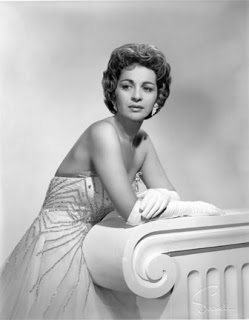Isn’t She Lovely?

This publicity photo of singer Gogi Grant catches the lady in an unfamiliar pose, looking like a major beauty. In real life, she didn’t lead with her beauty; she had a wonderful singing voice, and the high point of her career was her hit recording of the song, “The Wayward Wind.” She then did the singing for a non-singer movie star (remember “Singin’ in the Rain?” Same concept), not something that garners much renown. She also recorded a fairly high-profile cast album with a major film and stage star of the 1950s, Howard Keel. You can find all this in more detail on Wiki or wherever. What I’m driving at is that no matter what she looked like, much of her career was based not on her looks, but on how she sounded. To compound this, her record labels issued her albums with perky or winsome covers pics of her in the total cliché style of the 1950s. They did nothing to match the beauty of her voice with her physical beauty.
But she was stunning. Photos don’t lie, do they? Of course they do. Sometimes they catch what the personality of a person tends to overwhelm. How many people every saw Gogi Grant in repose like this, with her beauty simply shining forth? Or, are we looking at the result of a high-quality, hand-retouching job? I used to know a lady who did retouching at home in the evenings. Her day job was being a housewife, and she was quite a gardener, too. Plus she made braided rag rugs. To earn money, at night she’d haul out her equipment, set up a special lightbox and attach a photo to it, and then take a thin implement and touch up the negative. I don’t know how she got the strength, with all she had to do every day. I’m sure the photos she retouched ended up looking fabulous.
Perhaps we dare not trust this photo of Gogi Grant, then. Maybe she never looked this good in real life. Or maybe the photographer caught her in just the right lighting and pose to create a completely false illusion about what she looked like. I’ve known people who were brunettes who photographed blond. And of course we all know the concept of people whom “the camera loves,” who don’t look so great in person, but whose faces show interesting angles and crags through the camera’s selective artistry. Back then, it wasn’t easy. Today, we’ve got Photoshop and other manipulative tools to turn reality into illusion.
What does this have to do with romance, you ask. Well, some heroines of romances are stunning beauties, à la Ms Grant in her prime (she’s still alive, in her eighties, and still performing). This occurs most often in historical romances, because in times when women didn’t have much personal freedom, how they looked could be a major chip in the game, leapfrogging them to an exalted position in life to which their money and lineage would not otherwise entitle them.
The majority of romance heroines are wallflowers.
What is a wallflower? In botany it’s a rather unimpressive little flower that can grow in the mortar of a wall. At social dances, wallflower was the name given to describe the shy girls who were not beauties and didn’t have sparkling personalities, and therefore did not get asked to dance. The social rules of the past required these young women to stand or sit around the edges of the ballroom (watching enviously) while couples danced in the center: hence, wallflowers.
Which kind of romance heroine do you want to be? The princess type with luxuriant red-gold hair and stunning beauty? Or possibly the modern, middle-class heroine who feels most comfortable in a library, and hates being the center of attention? Or can you have it both ways? Of course. What is the big makeover scene or the big party or ballroom scene in most romances but the opportunity for the heroine to be a princess for a night—and let the world see her shine at last? It’s a pivotal scene in any romance. The heroine may ordinarily wear sweats or a uniform, with her hair any which way, but for this one event, she gets to be turned out to perfection. Just the way Gogi Grant is for this publicity photo.
How does a heroine of commonplace looks become a stunning beauty worthy of the hunky hero of a romance? She doesn’t, even though she’ll have her brief moment of looking her best. Instead, during the story she becomes the best version of herself she can be—inside, not outside. Her increasing self-confidence (although her circumstances may actually get more tenuous temporarily) makes her shine with a corresponding inner beauty that attracts the hero. He falls in love and thus she becomes beautiful in his eyes. No ballgown or makeover necessary.
A heroine of romance is always in the process of becoming. She isn’t a static thing of beauty. Her interaction with the hero helps to bring out her finer qualities, even as their conflicts test her mettle in a variety of ways. Heroes also are tested, of course. It’s not enough for them to spout (or think) endless compliments about how beautiful the heroine is. There’s got to be appreciation for who she is as a person. Even raving beauties have their moments of being less than beautiful, and the romantic ideal includes accepting the other in full humanity, not merely celebrity red carpet perfect.
Meanwhile, though, even if it was only for this one photograph, isn’t she lovely?
